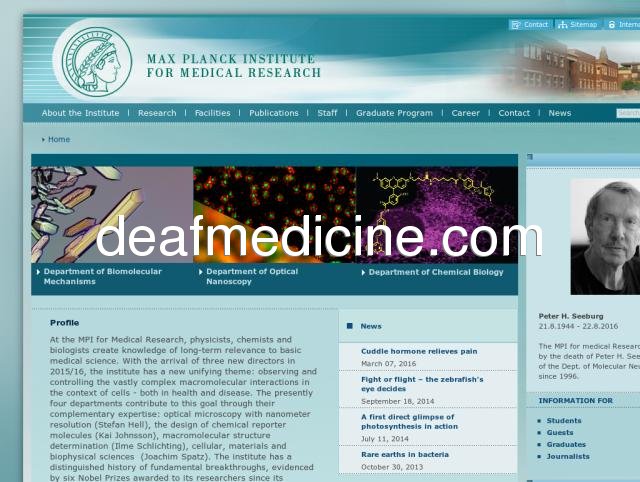www.mpimf-heidelberg.mpg.de Review:
http://buy-viagra-online-1.com/w/www.mpimf-heidelberg.mpg.de.html
Home | Max Planck Institute for Medical Research - The institute was opened in 1930 as the Kaiser Wilhelm Institute for Medical Research, and was re-founded as a Max Planck Institute in 1948. Its original goal was to apply the methods of physics and chemistry to basic medical research, and it included departments of Chemistry, Physiology, and Biophysics. In the 1960s, new developments in biology were reflected with the establishment of the Department of Molecular Biology. Toward the end of the 1980s and during the 1990s, investigations began into the specific functions of muscle and nerve cells. New departments were established in Cell Physiology (1989), Molecular Cell Research (1992-1999), Molecular Neurobiology (1995), Biomedical Optics (1999) and Biomolecular Mechanisms (2002). The independent junior research groups for Ion Channel Structure (1997-2003) and Developmental Genetics of the nervous System (1999) were also founded. Since its foundation, five Nobel Prizewinners have worked at the institute: Meyerhof (Physiology), Kuhn (Chemistry), Bothe (Physics), Mößbauer (Physics) and Sakmann (Physiology or Medicine). The institute currently has three departments and two independent junior research groups. The Department of Molecular Neurobiology focuses on the analysis and altering of mouse genes that are responsible for rapid signaling in the brain; the purpose is to investigate which brain capacities are inherited and which are learned. The Department of Biomedical Optics studies the activity of groups of nerve cells in tissue preparations and in laboratory animals with the use and continued development of multiquantum microscopy. The research in the Department of Biomolecular Mechanisms is aimed at establishing the molecular basis of model reactions, using the methods of biophysics and structural biology.

Country: 134.76.31.205, Europe, DE
City: 9.9333 Lower Saxony, Germany
Good for cutting bruise duration in about half. Helps a lot to resolve inflammation much faster. It is very useful after surgery, laser treatments, injuries of any type. It can be taken a few days for minor bruise resolution (from laser or a bump) or longer periods (6 weeks, 3 months, 6 months) for surgery, surgical wounds, and major trauma. My plastic surgeon prescribed it for my surgical wounds and trauma, and instructed me to take one pill (40,000 units) every six hours away from food (1 hour before or 2 after). My Dr. said I could cut the dose in half after 6 weeks if I wanted, or could continue with the initial dose for six months or even longer. My Dr. advised me to rest for a week or two at 3 months and continue until I finished treatment. It speeds up healing. It reduces scar tissue.
Have only used it for one month, but I could see a big difference already. Looking forward to seeing what happens next month.
I have been using this for about a month now. This Retinol Cream from Uptown Cosmeceuticals feels so smooth on your skin. It is very moisturizing, but does not make your skin feel greasy or oily. I've been wanting to try a retinol product for a while now , but some of the ones I've looked at are very costly. Besides the 2.5 % retinol, this one also contains organic aloe, green tea, jajoba oil and shea butter. I have also used it on the backs of my hands, and it does seem to be reducing the brown spots. *I did receive this item at a discount in exchange for my unbiased review.
I really like this hair care product - I got the Wen Set of Three for Fine-Medium Hair - and I've been using it since I received it. I only use about 4 pumps tho - and don't really need any more after I've rinsed for conditioning. My hair is soft, shiny and manageable.